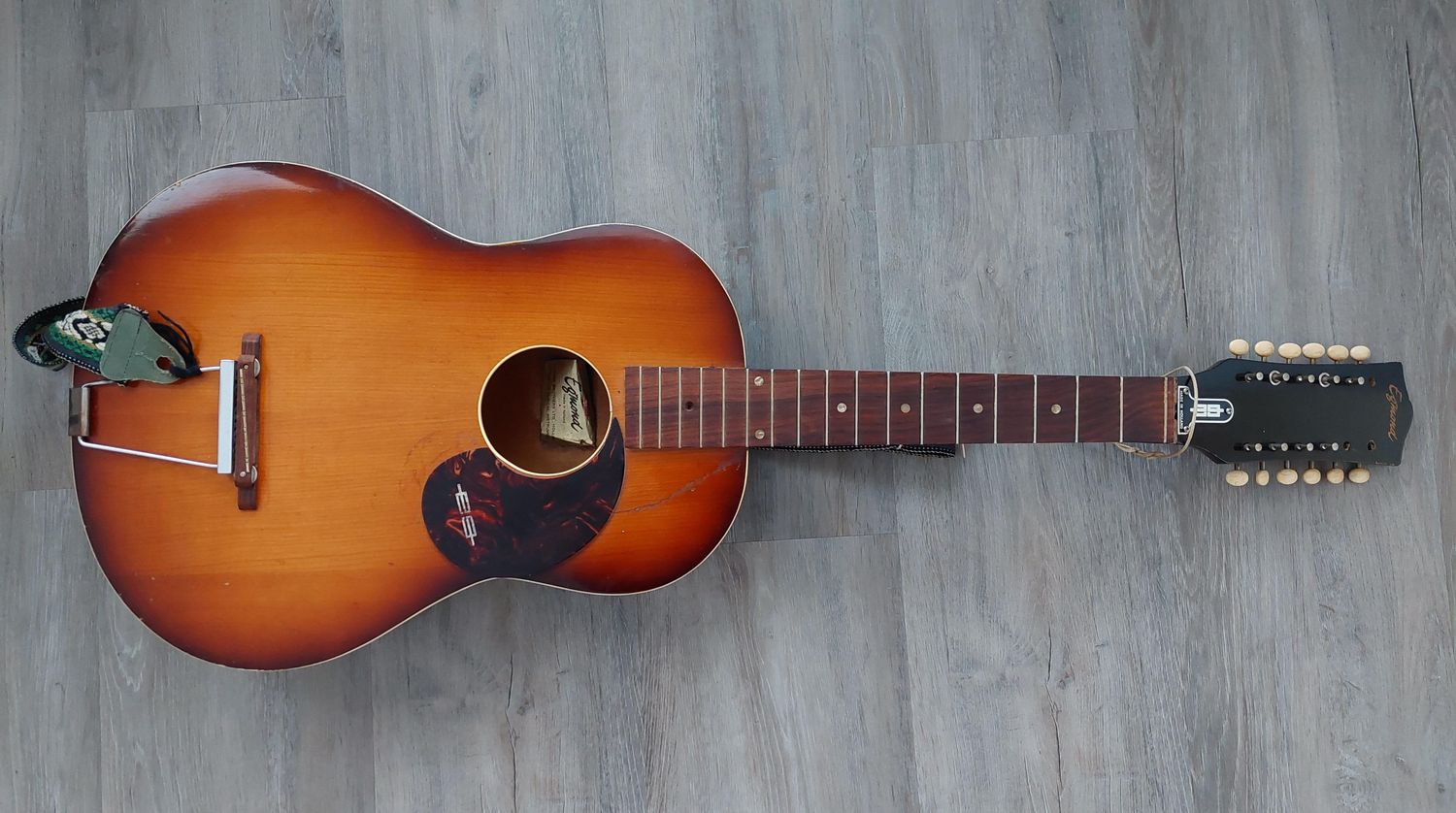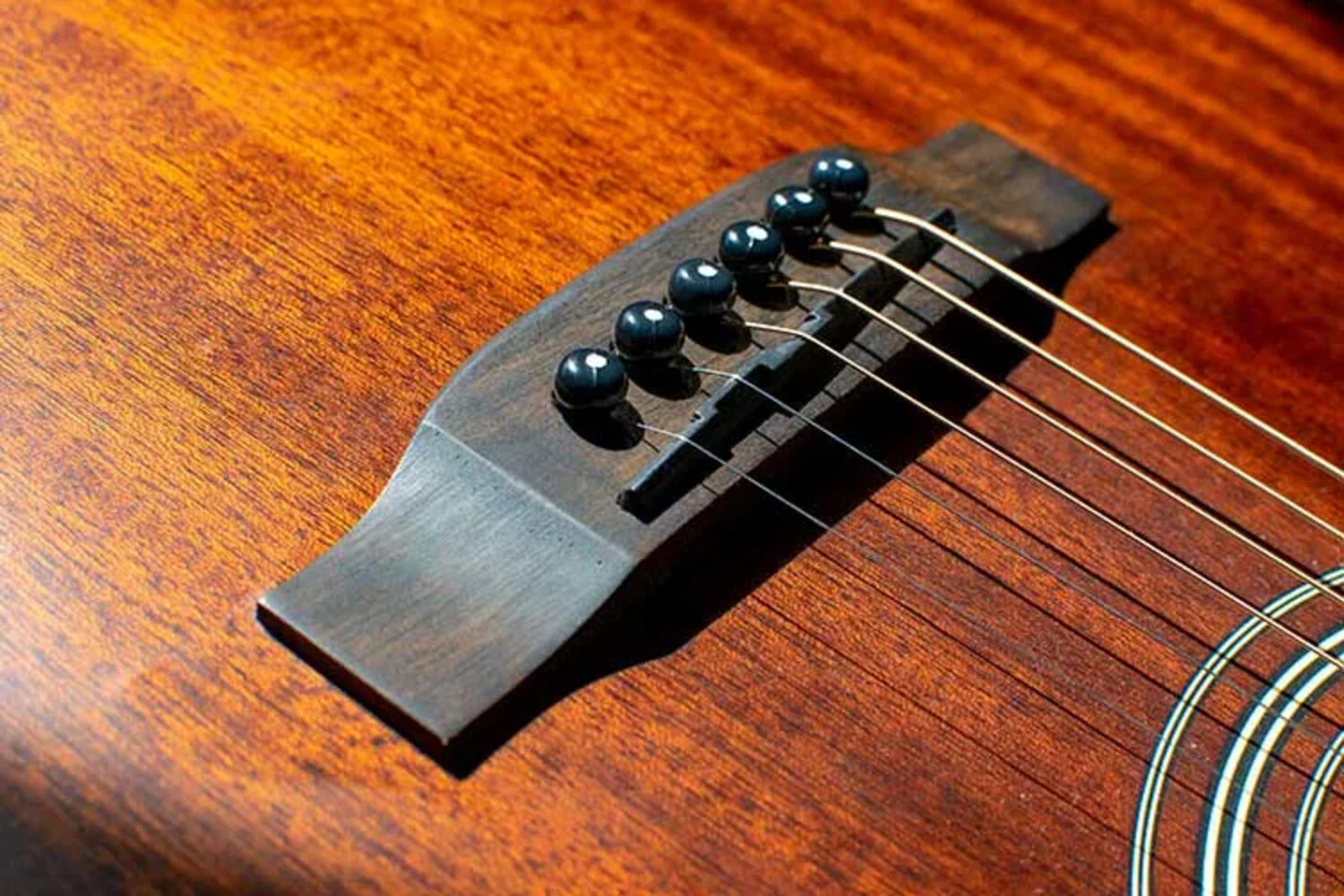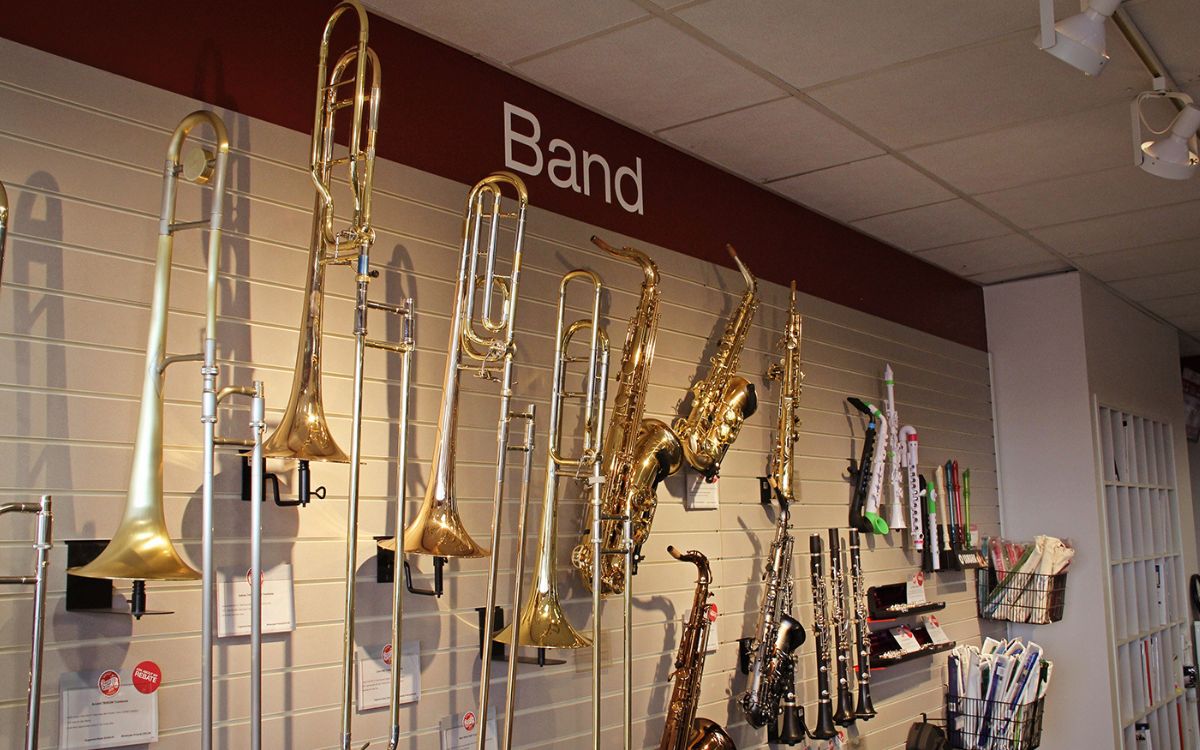Home>Instruments>Guitar>What Are The Parts Of A Guitar


Guitar
What Are The Parts Of A Guitar
Published: February 15, 2024
Learn about the essential parts of a guitar, including the body, neck, fretboard, and more. Understand how each component contributes to the instrument's sound and playability. Explore the anatomy of a guitar to enhance your playing and maintenance knowledge.
(Many of the links in this article redirect to a specific reviewed product. Your purchase of these products through affiliate links helps to generate commission for AudioLover.com, at no extra cost. Learn more)
Table of Contents
Introduction
When you pick up a guitar, you’re holding a versatile and iconic instrument that has been a cornerstone of music for centuries. Whether you’re strumming an acoustic around a campfire or shredding an electric guitar on stage, understanding the different parts of a guitar can deepen your appreciation for its craftsmanship and enhance your playing experience.
In this comprehensive guide, we’ll explore the anatomy of both acoustic and electric guitars, shedding light on the distinct components that contribute to their unique sounds and playability. From the headstock to the bridge, each part plays a crucial role in shaping the instrument’s tone and character.
By delving into the intricate details of a guitar’s construction, you’ll gain a deeper understanding of how these components work together to produce the rich, resonant tones that have captivated music lovers across genres. So, let’s embark on a fascinating journey through the parts of a guitar, unraveling the secrets behind this beloved instrument’s timeless appeal.
Body
As we dissect the anatomy of a guitar, we uncover a symphony of interconnected components that contribute to its sonic and visual allure. From the neck to the strings, each part plays a pivotal role in defining the instrument’s playability, tone, and aesthetic charm. Let’s embark on a captivating exploration of the various elements that constitute a guitar, unraveling the magic behind its melodic prowess.
1. Neck: The neck serves as the guitar’s central axis, providing a foundation for fretting and navigating the fingerboard. It typically consists of a solid piece of wood, such as maple or mahogany, and is adorned with frets and inlays that aid in chord formation and scale traversal.
2. Headstock: Situated at the top of the neck, the headstock houses the tuning pegs, which allow players to adjust the tension of the strings, thereby tuning the instrument to the desired pitches. The headstock also bears the guitar’s brand insignia, adding a touch of visual distinction.
3. Tuning Pegs: These small, cylindrical pegs are integral to the tuning process, enabling musicians to tighten or loosen the strings to achieve precise pitches. Their smooth rotation facilitates fine adjustments, ensuring that the guitar stays in tune during performances and practice sessions.
4. Fretboard: Positioned atop the neck, the fretboard, also known as the fingerboard, provides a smooth surface for pressing down on the strings to produce different notes and chords. It is typically crafted from rosewood, ebony, or maple and is adorned with fret markers that aid in orientation and chord formation.
5. Frets: These thin metal strips are embedded along the fretboard at specific intervals, dividing it into distinct semitones. By pressing the strings against the frets, players can alter the pitch of the notes, unleashing a myriad of melodies and harmonies.
As we delve deeper into the anatomy of the guitar, we’ll uncover more fascinating components that contribute to its sonic and visual splendor. Stay tuned as we unravel the secrets behind the body, soundhole, bridge, pickguard, and strings, shedding light on the intricate craftsmanship that defines this beloved instrument.
Neck
The neck of a guitar is a vital component that significantly influences playability and tonal characteristics. Crafted from sturdy woods such as maple, mahogany, or rosewood, the neck provides structural support and serves as the primary avenue for hand movement along the fingerboard.
One of the key features of the neck is the fretboard, also known as the fingerboard, which is typically made from durable and smooth materials like rosewood or ebony. This is where the player positions their fingers to produce different notes, chords, and melodies. The fretboard is adorned with fret markers, usually dots or inlays, that assist in navigating the fingerboard and locating specific fret positions.
The frets, thin metal strips embedded along the fretboard at precise intervals, play a crucial role in defining the pitch of the notes. As the player presses the strings against the frets, they effectively alter the length of the vibrating string, producing varied pitches and musical expressions.
Furthermore, the neck often features a truss rod, an adjustable metal rod that runs through it, providing structural reinforcement and allowing for the adjustment of the neck’s curvature. This feature is essential for maintaining the optimal playability of the guitar, as it enables the player to counteract the effects of string tension and environmental factors on the neck’s straightness.
Additionally, the headstock, located at the top of the neck, serves as the anchor for the tuning pegs, which enable the player to adjust the tension of the strings, thereby achieving precise tuning. The headstock also bears the guitar’s brand insignia, contributing to its visual identity.
Overall, the neck of a guitar is a testament to meticulous craftsmanship and engineering, playing a fundamental role in shaping the instrument’s sonic capabilities and ergonomic design. Its seamless integration with the body and headstock underscores its significance in the holistic construction of the guitar, making it a cornerstone of both acoustic and electric instruments.
Headstock
The headstock of a guitar is a distinctive and functional component that contributes to the instrument’s tuning stability and visual appeal. Positioned at the top of the neck, the headstock serves as the anchor for the tuning pegs, which play a pivotal role in adjusting the tension of the strings to achieve precise pitches.
One of the defining features of the headstock is its unique shape and design, often reflecting the aesthetic identity of the guitar’s manufacturer. Whether it boasts a traditional, symmetrical silhouette or a sleek, modern profile, the headstock adds a touch of visual distinction to the instrument, making it instantly recognizable to seasoned musicians and enthusiasts alike.
The tuning pegs, housed within the headstock, are essential for the accurate tuning of the guitar. By rotating these pegs, players can tighten or loosen the strings, thereby adjusting their tension to produce the desired pitches. This process is integral to ensuring that the guitar remains in tune during performances and practice sessions, underscoring the significance of the headstock in maintaining the instrument’s sonic integrity.
Furthermore, the headstock often features the manufacturer’s logo or emblem, serving as a hallmark of quality and craftsmanship. This insignia not only adds a touch of sophistication to the instrument but also represents the legacy and heritage of the guitar’s maker, evoking a sense of pride and tradition among players and collectors.
From classic designs adorned with intricate inlays to minimalist headstocks exuding contemporary elegance, the visual diversity of headstock styles reflects the rich tapestry of guitar craftsmanship and design. Whether embellished with ornate details or embodying understated sophistication, the headstock stands as a testament to the artistry and precision that define the instrument.
In essence, the headstock of a guitar is more than a functional assembly of tuning pegs and strings; it is a canvas for artistic expression and a symbol of the instrument’s heritage. Its seamless integration with the neck and fretboard underscores its role as a unifying element in the guitar’s construction, embodying both form and function in perfect harmony.
Tuning Pegs
Tuning pegs, also known as machine heads or tuning machines, are fundamental components of a guitar’s headstock, playing a crucial role in determining the instrument’s pitch and tuning stability. These small, cylindrical pegs are intricately designed to allow for precise adjustments to the tension of the strings, enabling musicians to achieve accurate pitches and maintain tuning consistency.
Constructed with precision gears and shafts, tuning pegs facilitate the fine-tuning of each string’s tension, ensuring that the guitar produces the correct notes and harmonies. The smooth rotation of the pegs allows for incremental adjustments, empowering players to achieve the desired tuning with ease and accuracy.
One of the key attributes of high-quality tuning pegs is their ability to hold the tuned tension firmly, preventing slippage and maintaining the integrity of the instrument’s tuning. This reliability is essential for both live performances and recording sessions, where precise tuning is paramount for delivering captivating musical performances.
Moreover, the design and material composition of tuning pegs can significantly impact the overall aesthetic appeal of the guitar. Whether featuring sleek, chrome-plated surfaces or vintage-style, open-gear configurations, tuning pegs contribute to the visual identity of the instrument, complementing its overall design and enhancing its allure.
For acoustic guitars, the ratio of the tuning pegs plays a crucial role in determining the instrument’s tuning precision and stability. Higher gear ratios provide finer adjustments, allowing for more accurate tuning, while lower ratios may require more effort to achieve precise pitches. Understanding the nuances of tuning peg ratios empowers musicians to select instruments that align with their playing preferences and performance requirements.
From the graceful rotation of the pegs to the harmonious synchronization of string tension, tuning pegs embody the synergy between mechanical precision and musical expression. Their seamless integration within the headstock underscores their significance in shaping the tonal and visual characteristics of the guitar, making them indispensable components of this beloved instrument.
Fretboard
The fretboard, also referred to as the fingerboard, is a pivotal component of a guitar, serving as the primary platform for producing musical notes, chords, and melodies. Crafted from premium woods such as rosewood, ebony, or maple, the fretboard provides a smooth and durable surface for the player to press down on the strings, altering their vibrating length to produce distinct pitches.
One of the defining features of the fretboard is the arrangement of frets, thin metal strips embedded along its surface at precise intervals. These frets divide the fretboard into distinct semitones, allowing players to produce a wide range of musical expressions by pressing the strings against them at different positions. The placement of fingers on the fretboard in conjunction with strumming or picking techniques unlocks a myriad of harmonies and melodies, making the fretboard a canvas for creative musical exploration.
In addition to its functional role in note production, the fretboard often features inlays or fret markers, which serve as visual guides for players to orient themselves on the fingerboard. These markers, typically crafted from materials such as mother-of-pearl or acrylic, not only enhance the fretboard’s aesthetic appeal but also aid in identifying specific fret positions, facilitating seamless navigation and chord formation.
Furthermore, the curvature of the fretboard, known as the radius, influences the ease of playability and ergonomic comfort for the guitarist. Different guitar models may feature varying fretboard radii, catering to diverse playing styles and preferences. Whether it’s a flatter radius for effortless string bending and lead guitar techniques or a more pronounced curvature for comfortable chordal playing, the fretboard radius plays a crucial role in shaping the instrument’s overall feel and responsiveness.
As a testament to meticulous craftsmanship and attention to detail, the fretboard stands as a nexus of musical expression and tactile artistry. Its seamless integration with the guitar’s neck and frets underscores its significance in defining the instrument’s playability and tonal versatility, making it an indispensable element of the guitarist’s sonic journey.
Frets
The frets of a guitar are thin metal strips embedded along the fretboard, dividing it into precise intervals and enabling musicians to produce a diverse range of musical notes and harmonies. These meticulously positioned frets serve as the foundation for altering the pitch of the strings, allowing players to navigate the fingerboard and unleash captivating melodies and chords.
One of the key functions of frets is to facilitate the production of semitones, enabling the guitarist to create a chromatic scale and explore the full spectrum of musical expression. By pressing the strings against the frets at different positions, players effectively change the length of the vibrating string, resulting in varied pitches and tonal nuances. This seamless interaction between the player’s fingers and the frets unlocks a world of melodic possibilities, enriching the sonic tapestry of the guitar.
Moreover, the placement of frets along the fretboard is meticulously calculated to ensure accurate intonation and harmonic resonance across all positions. This precision is essential for maintaining consistent pitch accuracy and tonal clarity, allowing the guitar to deliver rich, resonant tones and seamless transitions between notes and chords.
Additionally, frets play a crucial role in defining the playability and ergonomic comfort of the guitar. The smooth and polished surfaces of the frets facilitate effortless string bending, vibrato techniques, and precise note articulation, empowering musicians to express themselves with finesse and fluidity. The tactile interaction between the player’s fingertips and the frets embodies the intimate connection between the artist and their instrument, adding a layer of tactile artistry to the act of playing the guitar.
As a testament to meticulous craftsmanship and engineering, the frets stand as a testament to the artistry and precision that define the instrument. Their seamless integration within the fretboard underscores their significance in shaping the guitar’s tonal and playability characteristics, making them indispensable components of this beloved instrument.
Body
The body of a guitar is a defining element that not only influences its visual appeal but also plays a pivotal role in shaping its tonal characteristics and resonance. Crafted with precision and attention to detail, the body of a guitar serves as a resonating chamber, amplifying the vibrations of the strings and projecting rich, vibrant tones.
One of the key components of the acoustic guitar body is the soundhole, a central aperture that allows the sound to escape and resonate, contributing to the instrument’s acoustic projection and warmth. The size and placement of the soundhole are meticulously designed to optimize the guitar’s tonal balance and volume, enhancing its sonic presence and articulation.
Furthermore, the bridge, located on the body of the guitar, anchors the strings and transmits their vibrations to the soundboard, facilitating the transfer of energy and contributing to the instrument’s rich, resonant sound. The material and construction of the bridge significantly impact the guitar’s sustain, clarity, and tonal characteristics, making it a crucial component in shaping the instrument’s sonic identity.
For acoustic guitars, the addition of a pickguard on the body serves both functional and aesthetic purposes, protecting the guitar’s finish from pick strikes while adding a touch of visual distinction. Whether adorned with ornate designs or featuring minimalist elegance, the pickguard complements the overall aesthetic of the guitar, reflecting the craftsmanship and artistry of its construction.
On the other hand, electric guitar bodies are designed to accommodate pickups, electronic controls, and hardware, contributing to their versatility and sonic adaptability. The construction and tonewood selection of electric guitar bodies significantly influence their sustain, resonance, and tonal nuances, making them a canvas for sonic exploration and artistic expression.
Whether it’s the graceful curves of an acoustic guitar or the sleek contours of an electric instrument, the body of a guitar embodies the marriage of form and function, seamlessly integrating visual allure with sonic resonance. Its role as a resonating chamber and a canvas for artistic expression underscores its significance in defining the instrument’s sonic identity and tactile appeal, making it an indispensable element of the guitarist’s musical journey.
Soundhole
The soundhole is a crucial feature of acoustic guitars, serving as a portal for the instrument’s sonic resonance and projection. Positioned on the guitar’s soundboard, the soundhole plays a pivotal role in shaping the instrument’s tonal characteristics, volume, and acoustic presence. Its design and placement are meticulously engineered to optimize the guitar’s sonic balance and projection, contributing to its rich, vibrant sound.
One of the primary functions of the soundhole is to allow the vibrations generated by the strings to escape from the internal chamber of the guitar, resulting in the amplification and projection of sound. This acoustic resonance enhances the instrument’s warmth, depth, and tonal complexity, creating a captivating sonic experience for both players and listeners.
The size and shape of the soundhole are carefully considered during the guitar’s construction, influencing its tonal balance and volume. Larger soundholes tend to produce a more pronounced and expansive sound, while smaller ones may emphasize clarity and focus. The placement of the soundhole is also strategically determined to optimize the distribution of sound waves, contributing to the guitar’s acoustic presence and projection.
Moreover, the soundhole serves as a visual focal point, adding a touch of elegance and craftsmanship to the guitar’s design. Whether adorned with intricate rosette patterns or featuring minimalist sophistication, the soundhole reflects the artistry and attention to detail that define the instrument’s visual allure.
From the graceful resonance that emanates through its aperture to the intricate patterns that adorn its surroundings, the soundhole stands as a testament to the marriage of form and function in guitar construction. Its seamless integration within the soundboard underscores its significance in shaping the instrument’s sonic identity and tactile appeal, making it an indispensable element of the acoustic guitar’s melodic journey.
Bridge
The bridge of a guitar is a fundamental component that anchors the strings to the body, transmitting their vibrations to the soundboard and contributing to the instrument’s resonance, sustain, and tonal characteristics. Whether it’s the graceful curves of an acoustic guitar bridge or the sleek design of an electric guitar bridge, this component plays a pivotal role in shaping the instrument’s sonic identity and playability.
For acoustic guitars, the bridge serves as a crucial interface between the strings and the soundboard, facilitating the transfer of energy and contributing to the instrument’s rich, resonant sound. Crafted from materials such as rosewood, ebony, or synthetic composites, the bridge’s construction significantly impacts the guitar’s tonal characteristics, sustain, and clarity. Its precise placement and design are meticulously engineered to optimize the instrument’s acoustic projection and tonal balance, enhancing its sonic presence and articulation.
Furthermore, the saddle, a small component positioned on the bridge, plays a pivotal role in determining the guitar’s intonation and string action. By adjusting the saddle’s position and height, musicians can fine-tune the instrument’s playability and ensure accurate pitch across all fret positions. This precision is essential for maintaining tonal clarity and harmonic resonance, making the bridge and saddle indispensable components in the guitarist’s sonic journey.
On the other hand, electric guitar bridges are designed to accommodate pickups, tremolo systems, and adjustable saddles, offering enhanced tonal versatility and playability. Whether it’s the vintage elegance of a traditional fixed bridge or the dynamic performance of a modern tremolo bridge, electric guitar bridges contribute to the instrument’s sonic adaptability and expressive potential, making them a cornerstone of sonic exploration and artistic innovation.
From the seamless transmission of string vibrations to the precise adjustment of intonation, the bridge embodies the marriage of form and function, seamlessly integrating visual allure with sonic resonance. Its role as a conduit for energy transfer and tonal shaping underscores its significance in defining the instrument’s sonic identity and tactile appeal, making it an indispensable element of the guitarist’s melodic odyssey.
Pickguard
The pickguard, a prominent feature on many acoustic and electric guitars, serves both functional and aesthetic purposes, adding a touch of visual distinction while protecting the instrument’s finish from pick strikes and scratches. Crafted from materials such as plastic, celluloid, or various synthetic composites, the pickguard complements the guitar’s overall design and reflects the artistry and attention to detail that define the instrument’s visual allure.
Functionally, the pickguard acts as a shield, safeguarding the guitar’s soundboard or body from the wear and tear that results from strumming or picking. Its presence ensures that the instrument’s finish remains pristine, preserving its aesthetic appeal and structural integrity over years of playing. This protective role is particularly crucial for vintage and high-end guitars, where maintaining the instrument’s visual allure is of paramount importance to collectors and enthusiasts.
Moreover, the pickguard serves as a canvas for artistic expression, featuring a wide array of designs, patterns, and colors that complement the guitar’s visual identity. Whether adorned with ornate motifs, minimalist embellishments, or custom graphics, the pickguard adds a layer of individuality and personalization to the instrument, reflecting the player’s unique style and artistic sensibilities.
For acoustic guitars, the pickguard’s placement on the soundboard contributes to the instrument’s visual appeal, enhancing its aesthetic symmetry and balance. Whether it’s a classic tortoiseshell pickguard on a vintage acoustic or a sleek, modern design on a contemporary instrument, the pickguard adds a touch of elegance and sophistication to the guitar’s overall aesthetic composition.
On electric guitars, the pickguard often accommodates pickups, switches, and electronic controls, serving as a functional platform for these components while adding a visual focal point to the instrument. Whether it’s a vintage-style pickguard on a traditional electric guitar or a custom-designed pickguard on a modern instrument, this component contributes to the instrument’s sonic adaptability and visual allure, making it a versatile and essential element of the electric guitarist’s sonic arsenal.
In essence, the pickguard stands as a testament to the marriage of form and function, seamlessly integrating visual allure with protective utility. Its role as a shield and artistic canvas underscores its significance in defining the instrument’s visual identity and tactile appeal, making it an indispensable element of the guitarist’s melodic journey.
Strings
The strings of a guitar are the conduits of musical expression, translating the player’s touch into resonant vibrations that form melodies, chords, and harmonies. Whether it’s the rich, warm tones of nylon strings on a classical guitar or the vibrant, expressive sound of steel strings on an acoustic or electric instrument, the choice of strings significantly influences the guitar’s tonal characteristics, playability, and sonic versatility.
Acoustic guitars typically feature steel strings, which produce bright, articulate tones and robust projection. These strings are available in various gauges, with lighter gauges offering enhanced playability and flexibility, while heavier gauges provide increased volume and tonal depth. The material composition of acoustic guitar strings, whether phosphor bronze, 80/20 bronze, or coated variants, contributes to their tonal warmth, sustain, and longevity, offering players a diverse range of sonic possibilities.
Classical guitars, on the other hand, are traditionally strung with nylon strings, renowned for their mellow, expressive tones and gentle, tactile feel. These strings, often featuring lower tension than steel strings, offer a smooth playing experience and are favored by musicians exploring fingerstyle techniques and classical repertoire. The nylon and wound bass strings of classical guitars contribute to their distinctive tonal character, offering a nuanced and intimate sonic palette.
Electric guitar strings, typically crafted from nickel-plated steel, offer enhanced magnetic responsiveness and dynamic range, making them ideal for producing the instrument’s signature overdriven tones and expressive bends. These strings are available in various gauges and constructions, catering to diverse playing styles and sonic preferences. Coated electric guitar strings provide extended longevity and tonal consistency, making them a popular choice for touring musicians and studio professionals.
String selection is a deeply personal choice for guitarists, with factors such as gauge, material composition, and winding method influencing the instrument’s playability and tonal expressiveness. Whether it’s the warm, mellow tones of nylon strings, the vibrant resonance of steel strings, or the dynamic versatility of electric guitar strings, the choice of strings is a cornerstone of sonic exploration and artistic expression for guitarists across genres.
Overall, the strings of a guitar stand as a testament to the marriage of craftsmanship and sonic expression, offering players a diverse sonic palette and tactile playing experience. Their role as the vehicle for musical articulation underscores their significance in shaping the instrument’s tonal identity and expressive potential, making them an indispensable element of the guitarist’s melodic odyssey.
Conclusion
Exploring the intricate anatomy of a guitar unveils a tapestry of components that converge to create an instrument of unparalleled sonic and visual allure. From the neck to the strings, each element plays a pivotal role in shaping the guitar’s tonal identity, playability, and aesthetic charm.
As we journeyed through the neck, headstock, tuning pegs, fretboard, frets, body, soundhole, bridge, pickguard, and strings, we uncovered the meticulous craftsmanship and engineering that define the guitar’s construction. The neck emerged as the central axis for fretting and hand movement, while the headstock and tuning pegs stood as guardians of tuning stability and visual distinction.
The fretboard and frets showcased the tactile artistry of musical expression, offering a canvas for melodic exploration and chordal resonance. The body, with its soundhole, bridge, and pickguard, served as a resonating chamber and visual focal point, elevating the guitar’s sonic presence and aesthetic allure.
Furthermore, the strings emerged as the conduits of musical expression, offering players a diverse range of sonic possibilities and tactile experiences. Whether it’s the vibrant resonance of steel strings, the warm tonal character of nylon strings, or the dynamic versatility of electric guitar strings, the choice of strings represents a cornerstone of sonic exploration and artistic expression.
In essence, the guitar’s anatomy is a testament to the marriage of form and function, seamlessly integrating visual allure with sonic resonance. Its role as a conduit for musical expression underscores its significance in shaping the instrument’s tonal identity and tactile appeal, making it an indispensable element of the guitarist’s melodic odyssey.
As we conclude this exploration, we invite you to delve deeper into the world of guitars, embracing the artistry and craftsmanship that define these beloved instruments. Whether you’re a seasoned musician or an aspiring player, the guitar’s anatomy offers a captivating journey of discovery, unlocking the secrets behind its timeless appeal and enduring legacy.
So, pick up your guitar, strum a chord, and let the harmonies resonate, for within its meticulously crafted form lies a world of musical enchantment and boundless creative expression.











